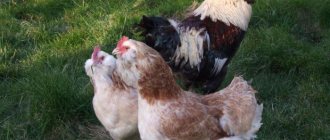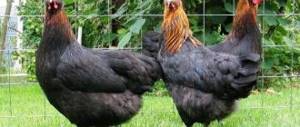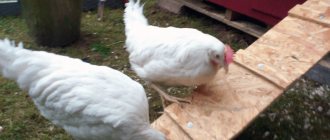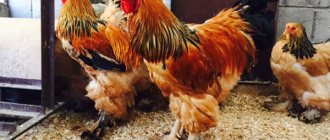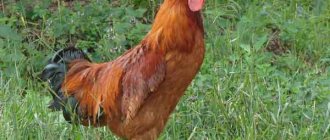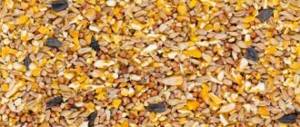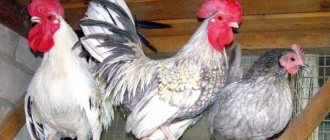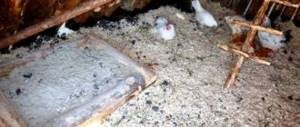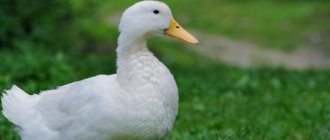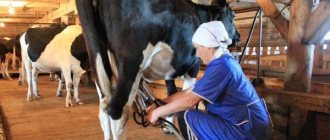Characteristics of the Leningrad breed of chickens
As you know, chickens are raised to produce eggs and meat, however, many breeders cannot decide which breed to choose or what to focus on. If you want to get all the privileges at the same time, we present to your attention the Leningrad Golden-gray breed of chickens, which is distinguished by its versatility! You will also learn about its varieties, Calico and White, each of which has its own attractive sides. In the article you will find information about the origin of the species, a detailed description of appearance and productivity, reviews, videos and vivid photos of all representatives.
Cost at poultry farms
The following farms and poultry farms are engaged in breeding the Leningrad calico breed:
- LLC "Hatchery" (Chekhov, Moscow region);
- FSUE "Genofund" (Shushary village, Leningrad region);
- All-Russian Research Institute of Poultry Science (Sergiev Posad, Moscow Region), etc.
Along with calico, white and gray breeds of chickens are also raised here.
The average cost of a hatching egg reaches 50-60 rubles, a chicken up to 14 days old - 150 rubles, and an adult - from 500 to 1,500 rubles, depending on the age of the birds.
Breed overview
The Leningrad breed belongs to the meat and egg breed and includes three varieties: Golden Gray, Calico and White. Each of them has its own strengths: Golden-gray is distinguished by its versatility, Calico attracts with its appearance and egg production, and White will surprise you with its impressive weight and growth rate. All of them are characterized by friendliness and good vitality: the survival rate of young animals is 93-95%, of adults - 80%.
Origin
The Leningrad breed is an artificially bred species. The first variety, Golden Gray, was developed through extensive experimentation during the 1970s and 80s. last century. To do this, scientists crossed Striped and Brown Leghorns.
Leningrad Whites were obtained in the 70s through repeated hybridizations. Researchers introduced Australorp blood to the White Leghorns. Thus, only in the fourth generation was the desired breed obtained. These chickens are superior to their ancestors in terms of survival, weight gain, growth rate and overall development.
The Leningrad Calico breed was registered in 1985. At that time, poultry farming and gardening were actively developing, so birds with beautiful appearance and good productivity were required. This variety was developed by crossing three breeds: New Hampshire, Black-and-White and Poltava Clay Australorp.
Appearance
Golden-gray chickens are distinguished by their large build, tall stature and wide body. In the area of the head and neck, as well as partially on the wings, the plumage is golden in color, the body is gray with an ashen tint. The comb is leaf-shaped, pink in color; earrings – white and pink. The skin is light with a yellowish tint. When chickens are one day old, their sex can be determined: hens have elongated dark stripes on their backs, and cockerels have a uniform light color without stripes.
Individuals of the Leningrad White variety are distinguished by their uniform white color. The body is massive, the chest is wide, the muscles are well developed. The neck is densely covered with feathers. Comb – leaf-shaped, red; earrings are red and white, medium size, beak and body are yellowish. The tail and wings are well developed, the latter are poorly attached to the body.
Leningrad Calico will decorate any household thanks to the unusual three-color color of the feather, where white, black and brownish colors are mixed. These are elegant birds with a compact, proportional build. Comb – leaf-shaped, pink; earrings – scarlet or pink. The skin of the paws and body is light with a yellowish tint.
Productivity
Golden-gray representatives reach weights of 2.3-2.5 kg for chickens and up to 3.2 kg for cockerels. They are distinguished by excellent egg production - up to 200 eggs per year. The average egg weight is 60-62 g, the shell is dense, white in color.
Calicos do not differ in special weight indicators: roosters - up to 2.7 kg, hens - 2.0–2.2 kg. However, their meat is very nutritious and contains many vitamins and minerals. Egg production - up to 180 eggs per year, which are notable for their excellent taste, compared to the product of other chickens. The weight of one egg is 58-60 g, inside of which there is a large bright yolk. The shell is light brown in color.
Leningrad Whites are raised mainly for the purpose of obtaining meat, since the weight of adult females reaches 2.9 kg, and males - 4 kg. Egg production in this case is 150-170 eggs. The shell is light brown, weight is 59-60 g. The young grow quickly, at 2 months the bird weighs 1.5 kg. They lay eggs early, starting at six months.
Main characteristics and description of the breed
Representatives of this breed are calm, friendly birds with a massive body and original plumage coloring. The main colors of the plumage are golden and gray tones. In the area of the neck and wings, golden feathers are clearly visible against the gray background of the main plumage. Body coloring is gray with an ashy tint. Long dark gray stripes run along the back.
The body is large and powerful, wide, its shape is correct. The male can weigh up to 3.5 kg, the female – up to 2.5 kg. At the exit after slaughter, the carcass of a rooster weighs up to 2.6 kg, that of a chicken - up to 2 kg, so the meat productivity of this breed is not the highest, but the taste of the meat is excellent - its tenderness and juiciness are beyond praise.
The head is medium in size, the comb is leaf-shaped, pink in color. Earrings are pale pink, medium size.
The limbs are medium in size, the metatarsus are unfeathered, pale yellow. The tail feathers are of medium size, well developed, lush and dense. The wings are medium in size and fit snugly to the body.
Laying hens of the Leningrad golden-gray breed have a fairly high egg productivity - one hen can lay up to 200 eggs per year. eggs The weight of one egg can reach 62 g. The color of the dense shell is dazzling white. The distinctive quality of such eggs is their very large yolk. Pullets are characterized by average sexual maturity - they lay their first eggs at six months.
Reviews
Breeders cannot get enough of the Leningrad breed! Particularly popular is the Golden-gray one, which is distinguished by its versatility: the weight is good, the egg production is excellent, and the chickens are very attractive in appearance. Many Russian poultry farmers call this species the best option of the St. Petersburg Gene Pool. Breeders also note their calm, friendly nature, which makes it possible to let individuals of different ages out for walking. Some note the record weight of eggs, for example, here is a photo of a product of this breed, which weighs as much as 96 grams!
They also speak well of the Calicos; although they are not large in size, they delight in egg production and very tasty, nutritious eggs. In addition, they delight the eye with their unusual tricolor plumage. This species is also called a “home incubator” by many and is used for hatching chickens.
Tendency to disease
As noted above, Leningrad calico chickens are not susceptible to any specific types of illness, but, unfortunately, like representatives of other breeds, if they are not cared for in good faith, they can easily catch an infection.
The most common chicken diseases and methods of treatment:
- Salmonellosis. Symptoms: watery eyes, foamy excrement, swollen joints, poor appetite and extreme thirst. The source of infection can be: droppings, food, water, air. Salmonellosis must be treated with Furozalidone (about 20 days) and Streptomycin (10 days).
- Coccidiosis. Symptoms: lack of appetite, increased thirst, drowsiness, indifference, blue comb, inflammation of the cloaca, difficulty moving. The disease is treated with Furacilin.
- Worm infestation. Symptoms: anxious state of the bird, severe diarrhea. Treatment is prescribed by a veterinarian based on the type of helminth.
- Trematodes. Symptoms: increased anxiety, inflamed cloaca, lack of shell on eggs. The disease is treated with carbon tetrachloride.
- Bronchopneumonia. Symptoms: poor appetite, heavy breathing, copious mucous discharge from the beak. Treatment should be with antibiotics: Penicillin and Terramycin.
Find out more about how to treat salmonellosis in chickens.
In order not to treat the listed diseases in the future and to keep the poultry yard in good health as much as possible, it is advisable to constantly adhere to the recommended preventive measures:
- vaccinate individuals in a timely manner;
- carefully monitor the cleanliness of the bird’s “home”, change the flooring, carry out disinfection, and do not forget about general cleaning;
- keep the feeders and drinkers clean, do not allow droppings to get into the containers;
- Promptly throw away wet food that has not been pecked by chickens.
Leningrad golden-gray breed of chickens
The golden-gray variety of the Leningrad breed of chickens belongs to the meat-egg type. For more than 40 years, it remains one of the most popular among owners of small private farms. She is loved for her high productivity, low maintenance requirements and pleasant appearance. A detailed description of the breed with photos and reviews will help farmers get to know this unpretentious bird better and appreciate it.
Leningrad golden-gray breed of chickens
Leningrad chickens photo
Typically, the peak egg production occurs in the first two years of a hen's life from the moment of the first laying. Subsequently, this figure begins to rapidly decline, making further keeping of these birds unprofitable.
As a result, farmers have to completely replace their herd every 2-2.5 years. If roosters over 2.5 years of age remain sexually active and the number of fertilized eggs does not decrease, then such males are not sent to slaughter along with the rest of the livestock.
Egg fertilization is about 82%. The maternal instinct in hens is well expressed, however, there are individuals who are bad hens, but this is rather an exception and depends on the conditions that have been created for the herd of a given breed and on the relationship between hens and roosters in the poultry house.
Individuals of the Leningrad Golden-gray breed are calm and friendly, even young cockerels do not start fights with other inhabitants of the chicken coop. Therefore, a flock of such chickens can be safely kept with representatives of other breeds of poultry.
Leningrad golden-gray chickens are characterized by high immunity, thanks to which the birds are practically not susceptible to most diseases characteristic of other breeds of this poultry. They also quickly adapt to different climatic conditions, do not require special care and are not picky about food.
Description of the Leningrad golden-gray chicken breed with photos
Representatives of this variety have an original, but discreet appearance. The color of the plumage is dominated by 2 colors - gray and golden yellow. An ash tint is present on the back, belly and hindquarters, while golden feathers adorn the neck, wing tips and part of the back.
Exterior characteristics
The average weight of a one-year-old rooster of this breed is 3.4 kg. Chickens are smaller; upon reaching sexual maturity, they gain about 2.5 kg.
Rooster and hen of the Leningrad breed
Features of the appearance of birds:
- massive, well-knit body of regular shape;
- a medium-length neck with a beautiful curve smoothly transitions into a convex chest;
- the back is short, straight, rather wide;
- the tail is lush, raised high;
- the head is small, it has a straight leaf-shaped comb of a pink hue;
- wheat-colored beak;
- pink earrings;
- the wings are of medium size, tightly pressed to the body;
- the legs are short with well-defined muscles on the thighs and legs;
- metatarsus pink.
Laying hens differ from roosters by being squat and more rounded in shape. They have a well-developed belly and a slightly shorter neck. The crest and wattles of females are smaller, and the tail is short.
Bird temperament
The character of the Leningrad chicken is calm and balanced. The birds are moderately active, love to walk in the yard, and readily forage. Conflicts almost never arise in a chicken coop, provided that the birds do not need anything and feel comfortable. Laying hens get along easily with other inhabitants of the farmstead. In case of threat, roosters are able to defend their family members. Golden-gray chickens of the Leningrad breed quickly get used to their owner and adapt well to the new environment.
Roosters of the Leningrad golden-gray breed
Productivity
Compared to other varieties of the Leningrad breed, white and calico, golden-gray laying hens show the highest egg productivity - 180–200 eggs per year weighing 62 g. The beginning of egg laying in pullets is at the age of 5–5.5 months.
Attention! Maximum egg production can be achieved by maintaining the correct lighting conditions and following feeding recommendations.
The live weight of an adult bird is 2.5–3.9 kg. The carcasses have a good presentation - the muscle fibers on the legs and chest are well defined, the skin is light with a slight yellowish tint. Bird meat has a delicate aroma and excellent taste. It can be used to prepare dietary soups, baby food, bake, stew and fry.
Pros and cons of the breed
The Leningrad breed line is valued by poultry farmers for the following qualities:
- versatility - laying hens produce nutritious, tasty meat and a large number of eggs;
- low maintenance requirements;
- rapid weight gain;
- early onset of puberty;
- autosexity - the sex of chickens can be easily determined at one day of age;
- balanced character, resistance to stress;
- strong immunity;
- high survival rates of young and adult livestock;
- adaptability to the Russian climate.
The disadvantages of the breed include poorly developed maternal instinct. Some hens sit on eggs, but most are reluctant to carry out their mission of breeding.
Leningrad chickens reviews of golden gray
Reviews from those who kept the breed.
Of the total number of reviews about Leningrad golden-gray chickens, below are those that most fully characterize this breed of poultry!
Mikhail, 44 years old. Chickens of this breed have been living on my farm for 5 years. I can say that they are the calmest inhabitants of the poultry house, not vocal and quite active. The egg production of laying hens is quite satisfactory. With an appropriate diet, relatively high meat productivity can be achieved. I would like to note that the diet should have enough vitamins and minerals. Otherwise, the chickens begin to peck at the laid eggs.
Elena, 36 years old. I keep these birds for two seasons. but I have already managed to appreciate the unpretentiousness of these chickens, their calm and friendly character, rapid weight gain and good egg production. After slaughter, the carcasses are neat and approximately the same size. but I would like to note that representatives of this breed do not like extreme heat - during this period they lose their appetite, gain weight worse and lay less eggs.
Tatyana, 54 years old. I decided to try to have chickens on my property and chose the Leningrad golden-gray ones. I liked their unpretentiousness - I keep them in the barn, fenced off a walking area where I made beds with herbs - and the chickens happily spend most of the warm season there. They lay eggs regularly, but they haven’t been slaughtered for meat yet - let them grow for another couple of months.
Features of keeping and caring for poultry
Even a novice poultry farmer can take care of representatives of this breed. The main thing is to provide the birds with a cozy home and organize a nutritious diet. You will also have to equip the chickens with a walk - physical activity and being in the fresh air will have a beneficial effect on immunity and productivity.
Arrangement of a barn for Leningrad chickens
The chicken coop is built on an elevated place so that it is not flooded by water after melting snow or heavy rain. The area is calculated based on the number of livestock. There should be 0.35 m2 of free space per 1 hen. The floor is made of adobe, and the walls and roof are well insulated. If you do this right away, there will be no need to heat the room in winter. The suitable temperature for keeping Leningrad chickens is +10…+26 ºС.
Features of care and maintenance in a private household
The Leningrad Golden breed is kept in a standard chicken coop, the area of which is calculated at the rate of one 0.5 square meter for each head. The room should be warm, dry, protected from drafts.
Look at how to build a chicken coop for 20 laying hens or a poultry house for 50 birds, and we also suggest you read an article on how to build a chicken coop inside for laying hens.
It is imperative to provide the possibility of ventilation and provide access to daylight inside. To increase daylight hours in the autumn-winter period, additional lighting is provided in the chicken coop.
The Leningrad Golden breed is kept in a standard chicken coop.
Nests are installed inside the chicken coop. Boxes measuring 40x40 centimeters are suitable for their manufacture. Nests are placed at a height of 60-70 centimeters above the floor, perches are installed at a height of 70-80 centimeters. Number of nests – 1 piece for 4-5 laying hens.
Advice. If chickens do not lay eggs in any nests, they must be moved to another place.
As an alternative to floor keeping, it is possible to organize the rearing of golden-gray Leningrad chickens in cages. However, with a lack of physical activity, the breed’s egg production can sharply decrease.
For free walking in the fresh air, a spacious enclosure is built for chickens. Leningrad golden-gray chickens do not tend to fly high, so the fence can be made no more than 1.5 meters high. If individual individuals are seen flying over the fence, their wings can be clipped.
[adsp-pro-5]
The chicken coop and aviary must be kept clean. The bedding in the room is changed at least once every 1.5-2 months. Twice a year, the chicken coop is thoroughly cleaned, combined with antiseptic treatment of all surfaces. To destroy parasites, walls can be washed with boiling water or treated with steam.
Chickens of this breed happily walk in a fenced run.
To “bathe” the birds, containers with sand and wood ash are placed inside the chicken coop. Chickens will clean their feathers themselves using this mixture to remove parasitic insects.
Features of raising chickens on a home farm
For breeding, physically healthy, highly productive individuals without defects in appearance are selected. Since there are rarely good brood hens among representatives of this breed, an incubator will be needed to produce young animals. The fertilization rate of eggs in Leningrad chickens is average - 80–85%, but the survival rate of chickens is high - 90–93%.
Chickens of the Leningrad golden-gray breed
The sex of the chicks is easy to determine - hens have dark stripes on their backs, while cockerels have a uniform color. Females fledge faster than males. The young are raised in a brooder under an infrared lamp. The suitable temperature for keeping in the first days of life is +30ºС. The box with chickens is placed in a dry, well-ventilated place, protected from drafts.
On the first day, babies are given only a boiled egg - 5 g per head. Next, new products are gradually introduced into the diet - steamed small cereals, green onions, low-fat cottage cheese. At one week of age, you can offer boiled fish and vegetables. To prevent intestinal infections, young animals are soldered with a weak pink solution of potassium permanganate.
Breeding Features
Puberty in calico chickens occurs at the age of 6 months. Farmers should not speed up the process of starting egg laying, so as not to provoke the development of salpingitis. A chicken family consists of 10 females and one male. Individuals without deviations from the standard, healthy and showing good productivity are allowed for breeding.
You don't need an incubator to hatch chicks - calico laying hens have retained their brooding instinct. No more than 7 eggs are placed under the hen, since representatives of this breed do not differ in large body size.
Caring for the young
The chicks hatch at 21 days. On the very first day, you can determine their sex - females have a longitudinal stripe on their backs, and males have a uniform color of down. Chicks are kept in a warm place on clean, soft bedding until they fledge. A month after birth, they are transferred to a common chicken coop.
Breed analogues
Analogues of the Leningradskaya chicken breed with a golden-gray color include representatives of meat and egg lines of domestic selection. These include:
- Kuchinsky Jubilee is an unpretentious bird with a beautiful appearance, calm character, adapted to our climate. Weight – 3–3.8 kg, egg production – 170 units per year.
- The Moscow Black is a beautiful bird bred in the Moscow region, famous for its undemanding conditions and diet. The weight of a rooster is close to 4 kg, laying hens weigh 2.8–3 kg. Egg productivity – 180 eggs.
- The Adler Silver is a massive bird with luxurious Colombian colors, unpretentious and balanced. Live weight – 3.2–3.8 kg, egg production – 170 eggs per year weighing 62–65 g.
Advantages and disadvantages of the breed
Calico chickens of Leningrad selection have many advantages:
- good presentation of carcasses;
- decorative appearance of birds;
- high egg productivity;
- rapid weight gain and excellent taste of meat;
- good adaptive qualities, cold resistance;
- undemanding conditions of detention;
- strong immunity;
- high survival rates of chickens and adult livestock;
- peaceful character;
- developed maternal instinct.
Birds of this species have few disadvantages. What farmers complain about is the low prevalence of the breed. Poultry farmers are faced with the problem of purchasing hatching eggs and chicks. Another disadvantage is small carcasses. In terms of live weight, this breed is inferior to white and golden-gray chicken of Leningrad selection.
Reviews from poultry farmers
Farmers who have had experience in keeping Leningrad women speak about them in a positive way. Many value them for their high quality products - large eggs, juicy, tasty meat. Poultry farmers pay attention to the ease of caring for their birds - laying hens do not require much attention, hardly get sick, and eat everything the owner gives. Farmers call the golden-gray breed one of the best for breeding at home.
Leningrad chickens with a golden-gray color deserve good reviews. These birds provide their owners with useful products without demanding anything special in return. They only need a cozy, clean coop and a well-balanced diet.
Content Features
For the Leningrad breed of chickens, the housing conditions are the same as for other varieties.
You need a chicken coop with soft, moisture-absorbing bedding, lighting and ventilation. She will spend most of her time there in winter. In the warm season, the chicken is often out on the run, so you will have to install a pen near the barn where there will be enough plant food.
These are unpretentious in nutrition. They willingly eat:
It is important to pay special attention to feeding chickens. From the first days of its life, the Leningrad broiler needs feed with a high calcium content. This microelement is needed to increase the intensity of weight gain. A lack of calcium in the diet will lead to slow weight gain. You can get the right amount from chalk, shell rock and eggshells.
Their immunity is strong. Birds rarely get sick. The only danger is fraught with errors in the maintenance of livestock, which can result in the manifestation of diseases of an infectious and parasitic nature.
[dzs_videogallery]
Golden gray
The first of the breeds bred at the Leningrad Research Institute. The most productive bird with high egg production rates for its average weight. This chicken is tall, has a large muscular chest and a large head. The plumage is gray and ashy. The color of the neck often shimmers with golden hues. The earrings and comb are pink. Laying hens have 2 brown or black lines on their backs.
This is a type of egg direction. The carcass weight is average. Roosters grow up to 3.5 kg, and hens - up to 2.7 kg.
But the Golden Gray bird has other advantages:
- unpretentiousness in content;
- high egg production - up to 200 eggs per year;
- Egg size. The average weight of one is 60-70 g.
It is also important that they are popular not only because of their high egg production, but also because of their appearance. They can often be found on domestic farms.
Leningradskaya white
Origin story. Created using the method of reusable blood transfusion in Leningrad. Blood was taken from the Australorp breed and transfused into white Leghorns. Chickens were selected for meat production. Even the very first chickens surpassed their parents in physical and psychological indicators: they were more active, more resilient, stronger, grew faster and exceeded their parents in weight. The breeders did not stop there and continued to transfuse blood to the Leghorns from the Australorps. Over time, the genetic properties of the descendants were fully established. The 4th generation was already bred not by blood transfusion, but by crossing chickens of the same type, that is, without the participation of other breeds. Representatives were selected based on external indicators and productivity characteristics.
Description of the breed. They differ in the following external features:
- small slightly rounded head;
- leaf-shaped comb;
- yellowish rather large beak;
- orange round eyes;
- earlobes are red or pink-white;
- neck with a lot of feathers;
- large breasts;
- not short, but wide body;
- yellowish skin;
- well developed wings;
- a long tail;
- limbs, with slight darkening towards the tips.
Productivity of the breed. The weight of roosters is about 4 kg, females - 3 kg. Number of eggs per year = 160-180 pieces. The egg weighs approximately 60 grams with a light brown shell. During the period of active growth of chicks, females acquire feathers much faster than roosters. In one week, babies gain weight up to one and a half kilograms. Survival of young animals is up to 95%, of fully formed birds up to 80%. It has excellent meat characteristics, well-developed thighs and breast. Already at the age of six months, hens begin to lay eggs. As the name suggests, the plumage is white, without any admixtures of other colors.
Reviews from poultry farmers. Those farmers who want to keep meat chickens are delighted with this breed. After all, the breed is impressive in its size and growth rate. In the Leningrad region, many private owners breed the white one on their own farms, and it is also preserved as a genetic reserve in collections.
White
They have a uniform color. The plumage color is snow-white. Scarlet comb and earrings. The appearance of this bird is impressive. Chickens are massive, have a developed loin and large wings.
White Leningrad variety
This hybrid has average egg production. A laying hen produces 150-170 eggs per year. White chickens have a good survival rate of over 80%.
The most important characteristics of this variety:
- Fast weight gain. By 2 months, chickens weigh 1.5-2 kg. Adult broilers gain weight up to 4.5 kg.
- Good survival rate, calm character.
- Early puberty. The bird has been laying eggs since 6 months.
White Chickens are less common in markets than Golden Gray Chickens.
Leningrad chicken is the best alternative to imported broilers
Author: Olga · Published 11/26/2018 · Updated 01/02/2019
It often happens in our Fatherland when everyone is chasing good imported goods and does not see the best of their own. This is what happened with the Leningrad White .
In the 80s, the Leningrad Institute of Poultry Breeding developed three varieties of Leningrad chickens:
- golden-gray Leningrad chickens are excellent layers;
- calico Leningrad chickens - perfect for lovers of decorative chickens with good egg production;
- white Leningrad chickens - meat and egg production.
All three varieties are descended from Leghorns and the best of the Australian fowl.
White Leningradskys differ from the other two varieties in their plumage, size and pronounced focus on quickly obtaining high-quality meat. The bird has snow-white plumage. And only their earrings and comb are red. If they sell a bird with spots of a different color on its white plumage, it means it is not purebred.
Read also: How and how to treat sinusitis in turkeys
calico birds
Leningrad Calico chicken is the youngest variety. When creating it, breeders paid attention to external features.
Leningrad Calico chicken
According to the description, chickens of this species are slender, have variegated white and black plumage, a rounded breast and a thin curved neck. The head is white or gray, the color of the border of the beak is pink. There is something aristocratic and sophisticated in her appearance. This bird will decorate any farm.
The Leningrad Calico breed of chickens weighs no more than 3 kg. And males weigh even less. Egg production is average - up to 180 pcs. in year.
Farmers value the Calico variety of winged pets for their tender, tasty meat. They don’t get much of it from one carcass. But if it is grown at home, and farming is done for oneself, and not for sale, the person will be satisfied with this.
Description of the Leningrad calico chicken
Calico chickens of domestic selection are inferior to the breeds from which they were bred in terms of live weight. For comparison, a golden-gray rooster weighs 3.3 kg, a white Leningrad rooster weighs 4 kg, and a calico rooster weighs only 2.7–2.8 kg. However, the new breed line is valued for the excellent taste of the meat - it is white, juicy, tender and nutritious.
Characteristic features of the exterior
The calico Leningrad chickens shown in the photo have an elegant appearance, although they do not belong to the decorative varieties. Each feather has 3 shades - white, brown-red and black. The combination of these colors creates an attractive colorful picture.
Requirements for the exterior of birds:
- compact body with well-developed chest;
- small head with a pink, leaf-shaped comb;
- earrings and earlobes are pale red;
- the beak is small, yellow-pink in color;
- back straight;
- Long neck;
- medium-sized wings, tightly pressed to the body;
- the tail is not long;
- the paws are straight, the metatarsals are bare, light in color with dark pigmentation;
- skin light yellow;
- the plumage is thick with a dense structure.
Bird temperament
Feedback from farmers about calico chickens is mostly positive. Birds cannot be called phlegmatic; they love to be active, walk, rummage in the ground and observe the situation in the yard. Despite this, the birds do not cause any inconvenience to neighbors in the area - they are moderately noisy and not aggressive. Calico chickens get along with each other and are willing to accept representatives of other breeds into their coop. In general they are quite friendly birds and easy to get along with.
Productivity indicators
Carcasses of the calico Leningrad breed have a good presentation. Although they are small, they are tasty, as evidenced by user reviews. Chickens are characterized by accelerated weight gain - by the age of two months, the chicken’s weight reaches 1.5 kg. This is a good indicator for birds of a universal direction.
The productivity characteristics of Leningrad calico chicken are presented below:
| Options | Indicators | |
| 1 | Average annual egg production | 160–180 pcs. |
| 2 | Average egg weight | 58–60 g |
| 3 | One year old rooster weight | 2.4–2.7 kg |
| 4 | Chicken weight | 2–2.2 kg |
| 5 | Chick survival rate | 95–96% |
| 6 | Safety of adult livestock | 80% |
In the first year of laying, pullets produce smaller eggs, and at the peak of egg production their weight increases by an average of 5% and reaches 60 g. In the second year, the productivity of laying hens decreases slightly. It is recommended to use chickens for 2 years, after which a planned replacement of the livestock should be carried out.
The eggs of calico laying hens are medium in size, but their yolk is 8–10% larger than that of representatives of other domestic breeds. The shell color is beige-brown.
Reference. A peculiarity of calico chickens is that females gain weight faster than roosters.
Hatching instinct
As a result of numerous crossings, new breeds of chickens rarely retain the brooding instinct. The Leningrad calico laying hen is an exception. She readily sits on the eggs and responsibly fulfills her role as a hen. Moreover, females know how to take care of hatched chicks, warming and protecting them.
How do chickens cope with winter cold?
Representatives of the breed variety under discussion are adapted to the Russian climate. They can be kept in an insulated chicken coop without the use of heating devices.
In the northern regions, if there are severe frosts and the temperature in the poultry house drops below +12 degrees, the room is heated.
Attention! Calico chickens are not afraid of the cold, but dampness and drafts are dangerous for them. It is important to seal all the cracks in the shed in the fall, and put a thick layer of bedding with peat on the floor to retain heat.
What to feed
The same diet as for other chickens is suitable for this breed - high-quality feed, grains, food waste and vegetables.
Read also: How to carefully trim the lawn?
Basic feeding tips:
- do not soak food to avoid food poisoning - it is better to give it dry;
- In winter, add protein to your diet, such as fish oil;
- periodically supplement the diet with mineral supplements;
- in summer, provide access to fresh grass, nettle will be especially useful;
- Chickens should have fresh water freely available.
At first, prepare a mixture of corn grits and ground eggs for the brood. On the third day of life, yogurt, cottage cheese, and green onions are added.
For raising individuals older than 10 days, special purchased crushed feed is suitable. Growing chickens need vitamin complexes and supplements. If possible, provide access to live protein foods - worms, beetles, slugs.
It is important to add just a little potassium permanganate to the chickens’ drinking water every 5 days. This will help avoid infection.
Adult chickens
In summer, adult individuals do not need a special diet; the main thing is to build an enclosure in a grassy and vegetative area. In winter, add premixes.
Make room in the chicken coop and aviary for containers with shell rock or fine gravel. This is necessary to ensure that the food is ground.
